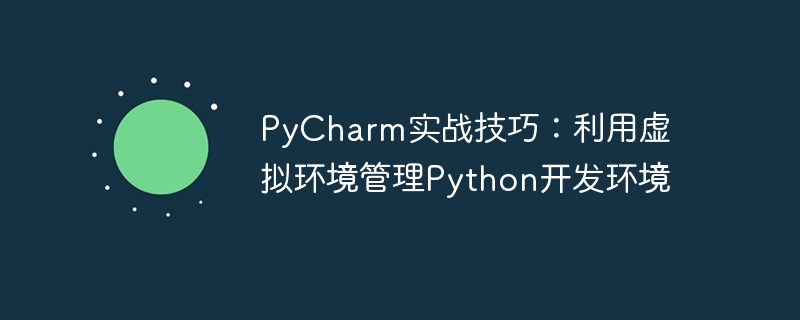

PyCharm is a powerful integrated development environment designed specifically for Python development. It provides many practical skills and functions to improve development efficiency. Among them, using a virtual environment to manage the Python development environment is a very important skill. Through the virtual environment, we can manage the dependency packages of multiple projects on the same machine to avoid issues such as version conflicts. This article will introduce how to use a virtual environment to manage the Python development environment in PyCharm, with specific code examples.
Creating a virtual environment in PyCharm is very simple. First, open PyCharm and select your project, then click "File" -> "Settings" -> "Project: YourProjectName" -> "Python Interpreter" in the menu bar. In the Python Interpreter menu on the right, click the gear icon in the upper right corner and select "Add..." to add a new Python interpreter.
In the pop-up dialog box, select "Virtualenv Environment" and click "OK". Next, select the path to the virtual environment and confirm creation. PyCharm will create a new virtual environment in this path, and your project will use the Python interpreter in this virtual environment.
After creating the virtual environment, you need to manually activate the virtual environment in PyCharm before you can use it. In the PyCharm terminal, enter the following command to activate the virtual environment:
source /path/to/your/venv/bin/activate
where /path/to/your/venv is the path to the virtual environment you created. Once the virtual environment is activated, you will see the virtual environment name appearing in front of the terminal prompt message, indicating that the current environment has been switched to the virtual environment.
In the virtual environment, you can use the pip command to install the dependency packages required for the project. After activating the virtual environment, use the following command to install the dependent package:
pip install package_name
where package_name is the name of the dependent package you want to install. PyCharm will automatically install dependency packages into the virtual environment to ensure that project dependencies are met.
The following is a simple sample code, create a virtual environment in PyCharm and install the requests library, send an HTTP GET request and output the response Content:
import requests url = 'https://jsonplaceholder.typicode.com/posts/1' response = requests.get(url) print(response.json())
In this example, we use a virtual environment to manage the Python development environment and use the requests library to send HTTP GET requests. Through the isolation of the virtual environment, the independence of project dependent packages is ensured and possible version conflicts are avoided.
Through the above practical skills, you can flexibly manage the Python development environment in PyCharm and use the virtual environment to improve the isolation and stability of the project. The virtual environment not only facilitates the management of dependent packages, but also allows you to easily switch development environments between different projects. I hope this article is helpful to you, welcome to explore more practical tips of PyCharm!
The above is the detailed content of Tips for managing Python development environment using PyCharm virtual environment. For more information, please follow other related articles on the PHP Chinese website!




